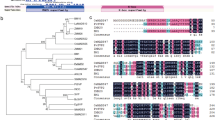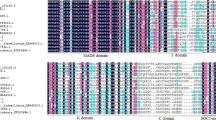Abstract
The MADS box genes are essential for floral development of Arabidopsis because they regulate flowering time and the development of floral organs. In this study, a MADS box gene, TaMADS1, was isolated and characterized from wheat (Triticum aestivum L.). The analysis of amino acid sequences and phylogenetic tree suggested that the TaMADS1 gene might be a SEPALLATA (SEP)-like gene. RNA hybridization indicated that the TaMADS1 transcripts began to accumulate in spikelets, and then, in floret primordia and floral organ primordia in wheat. In the later stage of floret development, the TaMADS1 transcripts accumulated in four whorls of young floral organs. The ectopic expression of TaMADS1 in Arabidopsis caused early flowering and altered the development of all floral organs. Further studies demonstrated that the early flowering phenotype in transgenic plants could be correlated with the upregulation of some flowering time genes and flower meristem identity genes. Our results suggest that TaMADS1 could be a putative SEP-like gene, and has diverse roles in flower development.






Similar content being viewed by others
Abbreviations
- CaMV:
-
Cauliflower mosaic virus
- GUS:
-
Beta-glucuronidase
- SEP :
-
SEPALLATA
- RT-PCR:
-
Reverse transcription polymerase chain reaction
- SSC:
-
Standard saline citrate
- SDS:
-
Sodium dodecyl sulfate
References
Ampomah-Dwamena C, Morris BA, Sutherland P, Veit B, Yao JL (2002) Down-regulation of TM29, a tomato SEPALLATA homolog, causes parthenocarpic fruit development and floral reversion. Plant Physiol 130:605–617
Angenent GC, Busscher M, Franken J, Mol JNM, van Tunen AJ (1992) Differential expression of two MADS box genes in wild type and mutant petunia flowers. Plant Cell 4:983–993
Angenent GC, Franken J, Busscher M, Weiss D, van Tunen AJ (1994) Co-suppression of the petunia homeotic gene fbp2 affects the identity of the generative meristem. Plant J 5:33–44
Araki T (2001) Transition from vegetative to reproductive phase. Curr Opin Plant Biol 4:63–68
Aubert D, Chen L, Moon YH, Martin D, Castle LA, Yang CH, Sung ZR (2001) EMF1, a novel protein involved in the control of shoot architecture and flowering in Arabidopsis. Plant Cell 13:1865–1875
Blázquez MA (2000) Flower development pathways. J Cell Sci 113:3547–3548
Blázquez MA, Weigel D (2000) Integration of floral inductive signals in Arabidopsis. Development 124:3835–3844
Bradley DJ, Ratcliffe O, Vincent C, Carpenter R, Coen E (1997) Inflorescence commitment and architecture in Arabidopsis. Science 275:80–83
Chen LJ, Cheng JC, Castle L, Sung ZR (1997) EMF genes regulate Arabidopsis inflorescence development. Plant Cell 9:2011–2024
Clough SJ, Bent AF (1998) Floral dip: a simplified method for Agrobacterium-mediated transformation of Arabidopsis thaliana. Plant J 16:735–743
Coupland G (1995) Flower development. LEAFY blooms in aspen. Nature 377:482–483
Ditta G, Pinyopich A, Robles P, Pelaz S, Yanofsky MF (2004) The SEP4 gene of Arabidopsis thaliana functions in floral organ and meristem identity. Curr Biol 14:1935–1940
Ferrario S, Immink RG, Shchennikova A, Busscher-Lange J, Angenent GC (2003) The MADS box gene FBP2 is required for SEPALLATA function in petunia. Plant Cell 15:914–925
Goodrich J, Puangsomlee P, Martin M, Long D, Meyerowitz EM, Coupland G (1997) A polycomb-group gene regulates homeotic gene expression in Arabidopsis. Nature 386:44–51
Greco R, Stagi L, Colombo L, Angenent GC, Sari-Gorla M, Pe ME (1997) MADS box genes expressed in developing inflorescences of rice and sorghum. Mol Gen Genet 253:615–623
Hama E, Takumi S, Ogihara Y, Murai K (2004) Pistillody is caused by alterations to the class-B MADS-box gene expression pattern in alloplasmic wheats. Planta 218:712–720
Honma T, Goto K (2001) Complexes of MADS-box proteins are sufficient to convert leaves into floral organs. Nature 409:525–529
Huang H, Tudor M, Weiss CA, Hu Y, Ma H (1995) The Arabidopsis MADS-box gene AGL3 is widely expressed and encodes a sequence-specific DNA-binding protein. Plant Mol Biol 28:549–567
Jeon JS, Jang S, Lee S, Nam J, Kim C, Lee SH, Chung YY, Kim SR, Lee YH, Cho YG, An G (2000) leafy hull sterile1 is a homeotic mutation in a rice MADS box gene affecting rice flower development. Plant Cell 12:871–884
Kang H, Jang S, Chung J, Cho Y, An G (1997) Characterization of two rice MADS box genes that control flowering time. Mol Cells 7:559–566
Lee H, Suh SS, Park E, Cho E, Ahn JH, Kim SG, Lee JS, Kwon YM, Lee I (2000) The AGAMOUS-like 20 MADS domain protein integrates floral inductive pathways in Arabidopsis. Genes Dev 14:2366–2367
Lenhard M, Bohnert A, Jürgens G, Laux T (2001) Termination of stem cell maintenance in Arabidopsis floral meristems by interactions between WUSCHEL and AGAMOUS. Cell 105:805–814
Liljegren SJ, Gustafson-Brown C, Pinyopich A, Ditta GS, Yanofsky MF (1999) Interactions among APETALA1, LEAFY, and TERMINAL FLOWER1 specify meristem fate. Plant Cell 11:1007–1008
Lohmann JU, Hong RL, Hobe M, Busch MA, Parcy F, Simon R, Weigel D (2001) A molecular link between stem cell regulation and floral patterning in Arabidopsis. Cell 105:793–803
Ma H, Yanofsky MF, Meyerowitz EM (1991) AGL1 AGL6, an Arabidopsis gene family with similarity to floral hometic and transcription factor genes. Genes Dev 5:484–495
Malcomber ST, Kellogg EA (2004) Heterogeneous expression patterns and separate roles of the SEPALLATA gene LEAFY HULL STERILE1 in grasses. Plant Cell 16:1692–1706
Mandel MA, Yanofsky MF (1995) A gene triggering flower formation in Arabidopsis. Nature 377:522–524
Mandel MA, Yanofsky MF (1998) The Arabidopsis AGL9 MADS box gene is expressed in young flower primordia. Sex Plant Reprod 11:22–28
Meguro A, Takumi S, Ogihara Y, Murai K (2003) WAG, a wheat AGAMOUS homolog, is associated with development of pistil-like stamens in alloplasmic wheats. Sex Plant Reprod 15:221–230
Moon J, Suh SS, Lee H, Choi KR, Hong CB, Paek NC, Kim SG, Lee I (2003a) The SOC1 MADS-box gene integrates vernalization and gibberellin signals for flowering in Arabidopsis. Plant J 35:613–623
Moon YH, Chen L, Pan RL, Chang HS, Zhu T, Maffeo DM, Sung ZR (2003b) EMF genes maintain vegetative development by repressing the flower program in Arabidopsis. Plant Cell 15:681–693
Münster T, Deleu W, Wingen LU, Ouzunova M, Cacharrón J, Faigl W, Werth S, Kim JTT, Saedler H, Theissen G (2002) Maize MADS-box genes galore. Maydica 47:287–301
Murai K, Murai R, Takumi S, Ogihara Y (1998) Cloning and characterization of cDNAs corresponding to the wheat MADS box genes. In: Slinkard AE (ed) Proceedings of the 9th international wheat genet symposium. University Extension Press, Sasketchewan, pp 89–94
Murai K, Takumi S, Koga H, Ogihara Y (2002) Pistillody, homeotic transformation of stamens into pistil-like structures, caused by nuclear-cytoplasm interaction in wheat. Plant J 29:169–181
Murai K, Miyamae M, Kato H, Takumi S, Ogihara Y (2003) WAP1, a wheat APETALA1 homolog, plays a central role in the phase transition from vegetative to reproductive growth. Plant Cell Physiol 44:1255–1265
Nam J, Kim J, Lee S, An G, Ma H, Nei M (2004) Type I MADS-box genes have experienced faster birth-and-death evolution than type II MADS-box genes in angiosperms. Proc Natl Acad Sci USA 101:1910–1915
Ng M, Yanofsky MF (2001) Function and evolution of the plant MADS-box genes. Nat Rev Genet 2:186–195
Nilsson O, Lee I, Blázquez MA, Weigel D (1998) Flowering time genes modulate the response to LEAFY activity. Genetics 150:403–410
Parcy F, Nilsson O, Busch MA, Weigel D (1998) A genetic framework for floral patterning. Nature 395:561–566
Parcy F, Bomblies K, Weigel D (2002) Interaction of LEAFY, AGAMOUS and TERMINAL FLOWER1 in maintaining floral meristem identity in Arabidopsis. Development 129:2519–2527
Pelaz S, Ditta GS, Baumann E, Wisman E, Yanofsky MF (2000) B and C floral organ identity functions require SEPALLATA MADS-box genes. Nature 405:200–203
Pelaz S, Gustafson-Brown C, Kohalmi SE, Crosby WL, Yanofsky MF (2001a) APETALA1 and SEPALLATA3 interact to promote flower development. Plant J 26:385–394
Pelaz S, Tapia-Lopez R, Alvarez-Buylla ER, Yanofsky MF (2001b) Conversion of leaves into petals in Arabidopsis. Curr Biol 11:182–184
Pelucchi N, Formara F, Favalli C, Masiero S, Lago C, Pe ME, Colombo L, Kate MM (2002) Comparative analysis of rice MADS-box genes expressed during flower development. Sex Plant Reprod 15:113–122
Pnueli L, Abu-Abeid M, Zamir D, Nacken W, Schwarz-Sommer Z, Lifschitz E (1991) The MADS box gene family in tomato: temporal expression during floral development, conserved secondary structures and homology with homeotic genes from Antirrhinum and Arabidopsis. Plant J 1:255–266
Pnueli L, Hareven D, Broday L, Hurwitz C, Lifschitz E (1994) The TM5 MADS box gene mediates organ differentiation in three inner whorls of tomato flowers. Plant Cell 6:175–186
Rounsley SD, Ditta GS, Yanofsky MF (1995) Diverse roles for MADS box genes in Arabidopsis development. Plant Cell 7:1259–1269
Sambrook J, Fritsch EF, Maniatis T (1989) Molecular cloning: a laboratory manual, 2nd edn. Cold Spring Harbor Laboratory Press, Cold Spring Harbor, New York
Savidge B, Rounsley SD, Yanofsky MF (1995) Temporal relationship between the transcription of two Arabidopsis MADS box genes and the floral organ identity genes. Plant Cell 7:721–733
Shannon S, Meeks-Wagner DR (1991) A mutation in the Arabidopsis TFL1 gene affects inflorescence meristem development. Plant Cell 3:877–892
Shchennikova AV, Shulga OA, Immink R, Skryabin KG (2004) Identification and characterization of four Chrysanthemum MADS-box genes, belonging to the APETALA1/FRUITFULL and SEPALLATA3 subfamilies. Plant Physiol 134:1632–1641
Sung ZR, Belachew A, Bai S, Bertrand-Garcia R (1992) EMF, an Arabidopsis gene required for vegetative shoot development. Science 258:1645–1647
Theiβen G, Becker A, Di Rosa A, Kanno A, Kim JT, Münster T, Winter KU, Saedler H (2000) A short history of MADS-box genes in plants. Plant Mol Biol 42:115–149
Theißen G (2001) Development of floral organ identity: stories from the MADS house. Curr Opin Plant Biol 4:75–85
Theißen G, Saedler H (2001) Plant biology. Floral quartets. Nature 409:469–471
Tzeng TY, Hsiao CC, Chi PJ, Yang CH (2003) Two lily SEPALLATA-like genes cause different effects on floral formation and floral transition in Arabidopsis. Plant Physiol 133:1091–1101
Vandenbussche M, Zethof J, Souer E, Koes R, Tornielli GB, Pezzotti M, Ferrario S, Angenent GC, Gerats T (2003) Toward the analysis of the petunia MADS box gene family by reverse and forward transposon insertion mutagenesis approaches: B, C, and D floral organ identity functions require SEPALLATA-like MADS box genes in petunia. Plant Cell 15:2680–2693
Weigel D, Meyerowitz EM (1993) Activation of floral homeotic genes in Arabidopsis. Science 261:1723–1726
Weigel D, Nilsson O (1995) A developmental switch sufficient for flower initiation in diverse plants. Nature 377:495–500
Zahn LM, Kong HZ, Leebens-Mack JH, Kim S, Soltis PS, Landherr LL, Soltis DE, dePamphilis CW, Ma H (2005) The evolution of the SEPALLATA subfamily of MADS-box genes: a pre-angiosperm origin with multiple duplications throughout angiosperm history. Genetics 169:2209–2223
Acknowledgments
We thank Dr. Y. B. Xue (Institute of Genetics and Developmental Biology, Chinese Academy of Sciences, Beijing) for his generous help with real-time quantitative PCR. This research was supported by the Project of Transgenic Plants, National Natural Science Foundation, the Major State Basic Research Program and the 863 Project of China.
Author information
Authors and Affiliations
Corresponding author
Rights and permissions
About this article
Cite this article
Zhao, X.Y., Cheng, Z.J. & Zhang, X.S. Overexpression of TaMADS1, a SEPALLATA-like gene in wheat, causes early flowering and the abnormal development of floral organs in Arabidopsis. Planta 223, 698–707 (2006). https://doi.org/10.1007/s00425-005-0123-x
Received:
Accepted:
Published:
Issue Date:
DOI: https://doi.org/10.1007/s00425-005-0123-x




